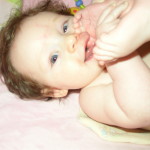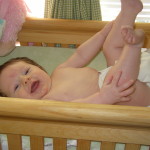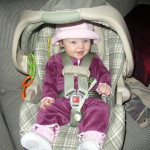Young children need routines, rituals, and predictability to feel secure in there environment. We are often creatures of habit but good habits are often learned and established to gain that sense of good health and feelings of security. In the post focused on singing to infants 0-9 months, I talked about moments of musical play to increase babies musical enrichment which helps foster bonding between parent and child. Songs can also help transition from one activity to another. One of the best techniques is singing or chanting while the children are helping to clean up instruments used during Music Together Classes or in Music Therapy sessions. My favorite is using the rhythmic chant, Saying and Doing, which is featured in this semester’s song collection, Flute, and adapting it to the clean up time.
“Cleaning up instruments, cleaning up instruments, cleaning and cleaning and cleaning up instruments!”
And, ”Helping our friends, helping our friends, helping and helping and helping our friends!”
Even if you don’t find yourself to be particularly “musical”, rest assured that your young child LOVES your VOICE! Your voice brings comfort and security to them as well. The more you sing, the better encouraged your child is to love music!
The following are some other ways you can use music throughout your child’s daily routine. Making tasks fun and enjoyable at a young age can help reinforce positive behavior and emotions. This is also important as children learn what is expected of them as valuable and helpful contributors to the family.
1. Waking up: Sing a wake up song to your infant or young children when you greet them in the morning. I often have sung the song, Good Morning from the musical, Singing in the Rain, to my children, but they have also heard, Frere Jacques, This is the Day, and the Music Together ”Family Favorite” song, Biddy, Biddy. Singing an upbeat and happy sounding song can help set the tone for the day ahead. Hearing your voice can bring comfort to your child after a nights sleep. Wake up songs help regulate mood and emotions and helps the body to physically wake up.
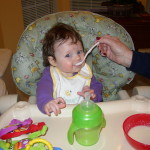 2. At Mealtime: Music is a great way to help pass the time when your child is nursing, taking their bottle, or learning to eat. Any fun song will do. Laurie Berkner’s Valley of Vegetables, the folk songs Sweet Potato and All Around the Kitchen are songs that speak directly about food and eating fun. Playing recorded music during meal times is also fine, but remember to sing along when you can to show your child how fun singing is! Also, grab a spoon and a pot and play along to the beat!
2. At Mealtime: Music is a great way to help pass the time when your child is nursing, taking their bottle, or learning to eat. Any fun song will do. Laurie Berkner’s Valley of Vegetables, the folk songs Sweet Potato and All Around the Kitchen are songs that speak directly about food and eating fun. Playing recorded music during meal times is also fine, but remember to sing along when you can to show your child how fun singing is! Also, grab a spoon and a pot and play along to the beat!
3. When changing diapers and potty training: Choose a fun, easy song and sing it every time your child’s diaper is changed or to help them sit on the potty. Pairing a song to an otherwise mundane ritual, such as when being changed, helps to create a more relaxing setting. The same is true for potty training. Singing a song can help define the length of time a child sits on the potty. Enjoyable songs are Twinkle, Twinkle, Little Star, Mary Wore a Red Dress (verses can be changed and made up to this tune), and She’ll Be Coming Round the Mountain.
4. While being buckled in: If there is one moment a song may help a potential negative experience, it is getting into the car seat. Babies and children often fuss and squirm. My own children when they were small often fussed in the car seat and singing to them helped. Just like changing diapers and potty training, singing a favorite song every time you help your child into their car seat may help calm them enough to get them buckled in with fewer protests. Although any fun song your child likes will do, several travel related songs include, Drive My Car by Laurie Berkner, Driving in the Car from Music Together, and Driving in My Car by Peter Allard.
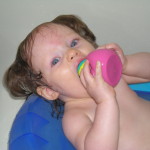 5. Sing during bath time and getting ready for bed: This is a great opportunity to sing about baths, bubbles, washing up, getting dry, brushing teeth and hair, and getting dressed for bed. Make up verses to tunes you already know like “I’ve been scrubbing in the bathtub, all the livelong day!” to the tune of I’ve Been Working on the Railroad. My kids enjoyed their daddy or me chanting Jack in the Box from the Music Together collection while they hid under their towels getting dry. Singing to the tune of Frere Jacques, you can make up a verse: “Brushing, brushing, scrub, scrub, scrub, cleaning your teeth, cleaning your teeth, polish your smile, polish your smile.”
5. Sing during bath time and getting ready for bed: This is a great opportunity to sing about baths, bubbles, washing up, getting dry, brushing teeth and hair, and getting dressed for bed. Make up verses to tunes you already know like “I’ve been scrubbing in the bathtub, all the livelong day!” to the tune of I’ve Been Working on the Railroad. My kids enjoyed their daddy or me chanting Jack in the Box from the Music Together collection while they hid under their towels getting dry. Singing to the tune of Frere Jacques, you can make up a verse: “Brushing, brushing, scrub, scrub, scrub, cleaning your teeth, cleaning your teeth, polish your smile, polish your smile.”
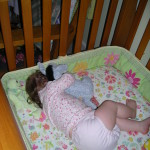 6. And don’t forget the lullaby moment: What a great way to finish the day, bond with your child, and say goodnight by singing one last song to your child before bedtime. Even if they are wiggly, singing a soothing song not only helps your child calm down but also is beneficial to focus you as the parent after a long day! Singing a lullaby helps to express your love for your child. The songs my children enjoyed when they were infants and toddlers were, Amazing Grace, Twinkle, Twinkle, Little Star, and Down in the Valley. As a bonus, having a good rocking chair for an easy rocking rhythm is great for that physical, rhythmic input that babies often crave to help calm their bodies.
6. And don’t forget the lullaby moment: What a great way to finish the day, bond with your child, and say goodnight by singing one last song to your child before bedtime. Even if they are wiggly, singing a soothing song not only helps your child calm down but also is beneficial to focus you as the parent after a long day! Singing a lullaby helps to express your love for your child. The songs my children enjoyed when they were infants and toddlers were, Amazing Grace, Twinkle, Twinkle, Little Star, and Down in the Valley. As a bonus, having a good rocking chair for an easy rocking rhythm is great for that physical, rhythmic input that babies often crave to help calm their bodies.
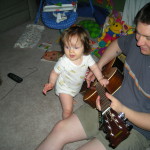 Singing with your child throughout their day is a great way to help foster musical appreciation, learn to sing, and increase rhythmic development in their growing brains and bodies. What are your favorite songs to sing to your child? What are your child’s favorite songs? How do you use music to make the most of your days? Feel free to leave a comment on the In Harmony Music of Middle Tennessee Facebook Page, and share this post with other families in our community of music makers!
Singing with your child throughout their day is a great way to help foster musical appreciation, learn to sing, and increase rhythmic development in their growing brains and bodies. What are your favorite songs to sing to your child? What are your child’s favorite songs? How do you use music to make the most of your days? Feel free to leave a comment on the In Harmony Music of Middle Tennessee Facebook Page, and share this post with other families in our community of music makers!
Music is moral law. It gives soul to the universe, wings to the mind, flight to the imagination and charm and gaiety to life and to everything – Plato
 Join a Music Together Class and learn songs that help get your child through their day!
Join a Music Together Class and learn songs that help get your child through their day!
 Carrie Friddell, MT-BC is a Board Certified Music Therapist, the Music Together Center Director and owner of In Harmony Music of Middle Tennessee. Find out more at: In Harmony Music of Middle Tennessee
Carrie Friddell, MT-BC is a Board Certified Music Therapist, the Music Together Center Director and owner of In Harmony Music of Middle Tennessee. Find out more at: In Harmony Music of Middle Tennessee

